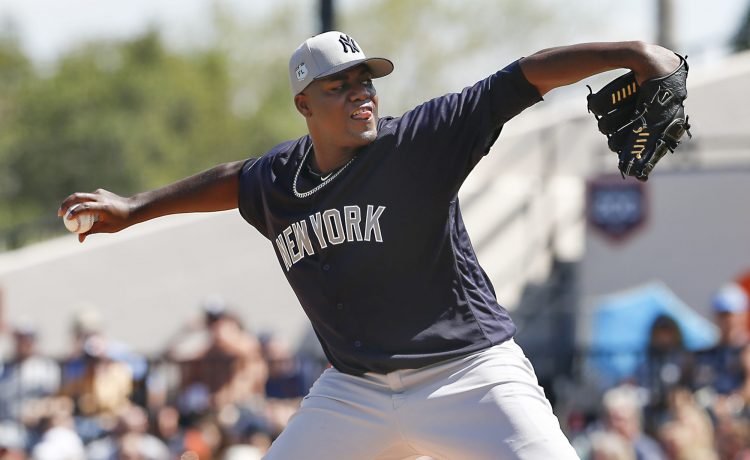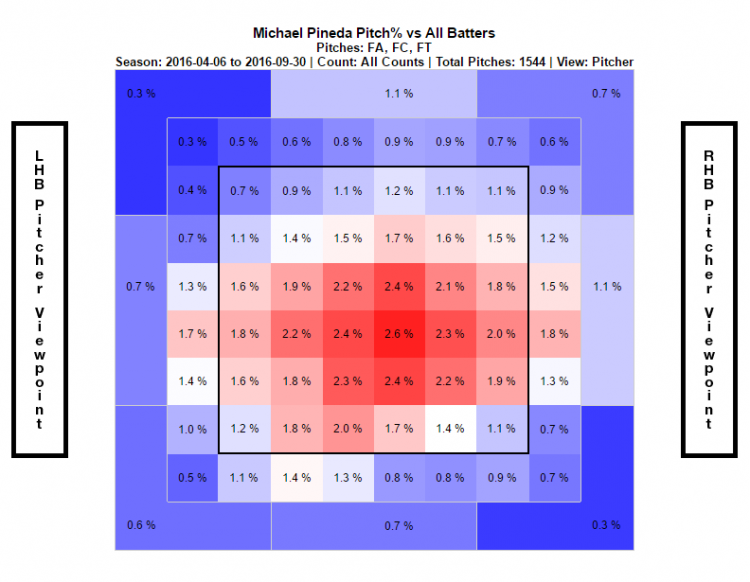
Over the last two seasons, seventy-six pitchers have thrown at least 300 IP. And, by at least one measure, Michael Pineda has been by far the most unlucky starting pitcher in baseball, with a 1.02 run difference between his ERA and FIP. The league-average gulf is 0.00, and only four pitchers are within half a run of Pineda (with Wade Miley and Gio Gonzalez coming closest, at 0.77).
Looking at it from another angle, his 111 ERA- (11% below-average) over the last two years ranks 69th within that group, while his 83 FIP- (17% above-average) places him 19th. The former metric puts him between Jeff Samardzija and Ubaldo Jimenez, whereas the latter ties him with Jeff Verlander and Zack Greinke; it’d be difficult to find two more distinct sets of pitchers to be a part of.
Luck, then, is a term that has been bandied about with Pineda quite a bit over the last two years. On some level, there remains hope that this is a long stretch of bad luck, and it’s easy to see why – he’s a 28-year-old whose strikeout and walk rates have placed him among elite company these last two years, after all. It’s never that simple, though.
The Good
There were plenty of things to like about Pineda’s 2016 season. The towering righty was in the top-ten in all of baseball in K% and K-BB%, and top-ten in the American League in strikeouts and FIP. His 45.8 GB% was a tick above league-average, he picked up swings on 37.8% of pitches outside of the strikezone (against a league-average of 30.3%), he allowed precious little contact (70.9%, versus a 78.2% league-average), and his fastball velocity jumped from 92.5 MPH in 2015 to 94.0 MPH last year.
In short, he regained lost velocity, racked up whiffs, limited walks, and kept the ball on the ground. What’s not to like?
The Bad
Pineda has earned a reputation for struggling to put hitters away, and that appears to be justified. As Mike pointed out in his season review:
And yet, with two strikes:
Pineda: .187/.246/.286 with a 47.6% strikeout rate
MLB Average: .176/.246/.276 with a 41.1% strikeout rateThe strikeout rate is nice, but Pineda’s overall numbers in two-strike counts are far too close to the league average pitcher for a guy with his stuff. Chad Green, whose slider isn’t nearly as good as Pineda’s, held hitters to a .135/.192/.281 batting line with two strikes. Those are the kind of numbers you’re looking for from Pineda.
This may be an issue with general pitch location, hanging sliders, sequencing, or any number of things, but the vast majority of above-average starting pitchers perform significantly better with two-strikes. It’s worth noting that this is something that Pineda is mindful of, and is said to be working on; a walk year would be a good time for him to make some improvements.
The Ugly
Batters teed off on all incarnations of Pineda’s fastball last year, batting .347 with a .619 SLG against the offerings (per Brooks Baseball). Or, phrased differently, batters turned into 2015 Bryce Harper when Pineda threw a fastball, which he did just over fifty-percent of the time. As per PITCHf/x it was the least-valuable pitch in baseball, checking in at -20.6 wFA (or 20.6 runs below-average).
That represents a significant drop-off from 2015, when the pitch was just 4.7 runs below-average, and may go a long way in determining how he ended up with a 4.82 ERA against a 3.80 FIP and 3.30 xFIP. Well, that, and the fact that his 1.38 HR/9 and 70.7 LOB% both ranked in the 20th percentile in all of baseball; this likely stems from his horrendous fastball, as well.
What made his fastball so bad? Location, location, location.

You see that red area, right in the middle of the strikezone? That’s where Pineda threw the majority of his fastballs last year; not on the black, not just outside the zone – right down the pike. It’s not too shocking that batters were able to hit .347 against the pitch with this in mind, particularly when you consider they hit .328 against it in 2015, when his location was incredibly similar.
The projection systems are bullish on Pineda, essentially buying into his strikeout and walk rates and forecasting significantly fewer home runs:
ZiPS – 156.2 IP, 9.4 K/9, 1.9 BB/9, 1.2 HR/9, 3.96 ERA
Steamer – 152.0 IP, 9.4 K/9, 2.2 BB/9, 1.1 HR/9, 3.51 ERA
PECOTA – 168.0 IP, 9.6 K/9, 2.6 BB/9, 1.2 HR/9, 3.60 ERA
Steamer and PECOTA actually prefer Pineda to Masahiro Tanaka, which is … interesting, I suppose. Regardless, I would be thrilled with any of those lines, as even ZiPS would represent a slightly above-average pitcher (based on ERA), which would be a significant improvement upon Pineda’s two full seasons in pinstripes.
Leave a Reply
You must be logged in to post a comment.